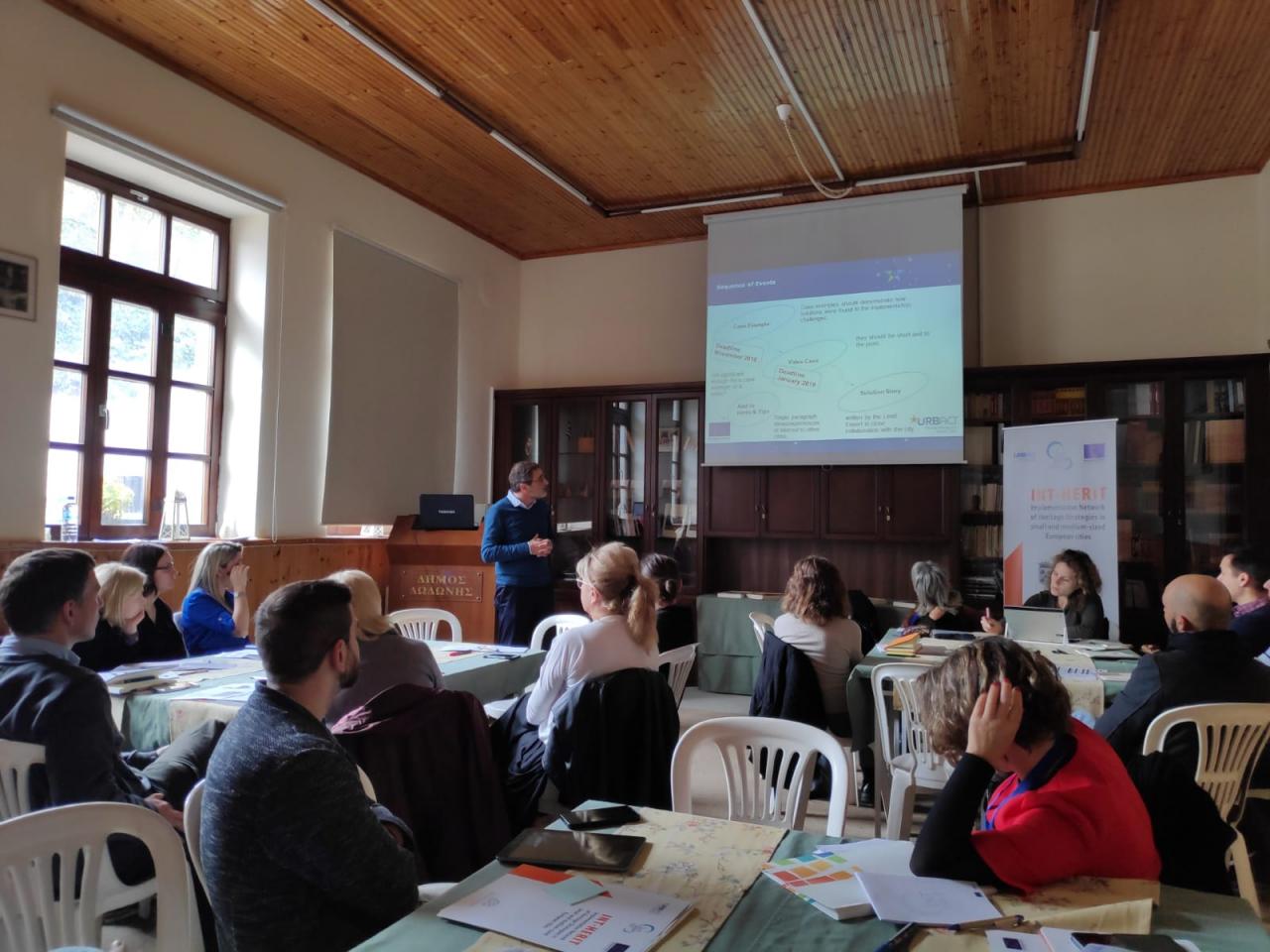
➔ Summary
The INT-HERIT Implementation Network is now identifying and collecting data about
the way small cities are tackling implementation challenges on their cultural heritage projects.
New smart, low cost initiatives are being implemented to overcome the traditional lack of
resources by adopting an integrative and participative approach towards stakeholders and
increase the value created for citizens through heritage conservation projects. This article
provides a preliminary insight on some of the initiatives currently taking place in the
participating cities in order to contribute for a knowledge base of solutions that will be
hopefully useful for many small cities across Europe.
➔ Planning vs Implementation
In recent years Strategic Urban Planning became a common practice in many small
European cities by using many of the tools and guidelines developed for bigger cities as these
are usually easy to transfer for the local context. This is the case of the cities participating in
the INT-HERIT that had developed their own strategic urban plans as a subset of these wider
plans found in big cities. However, when in the implementation phase the transferability of
these practices is harder to apply as implementation is an intrinsically local process that
requires specific solutions for specific local constraints. To overcome these challenges cities
are looking for ways to improve their implementation processes through an integrated and
participatory approach with local stakeholders.
➔ Building a knowledge base on implementation
Implementation has all sorts of constraints and variables that may influence the final results.
Identifying the factors behind it is not an obvious task due to the diversity of situations in each
city. To extract useful knowledge the network uses a methodology based in 'Case Examples'.
These are brief reports on how a city tackled a specific challenge. It highlights some specific
aspect of the Implementation Plan (a building or an initiative) by providing insight knowledge
of the experience on tackling a specific problem. This way the network expects to develop a
knowledge base on implementation (to be published online) showcasing different approaches
across participating cities, what particular details and common features are being discovered.

➔ Preliminary analysis of the 'Case Examples' - problems and solutions
In this sense we look in particular for initiatives and actions that go beyond the conservation
works in a strict sense and targeted one of the five Implementation Challenges initially
identified. Here’s some insight of the problems and solutions proposed in each participating
city.
In the last decade, the city of Baena (ES) has made important investments to rehabilitate the
archaeological site of Torreparedones and open it to visitors. However, as the excavation
progressed it became clear that part of the area occupied by this ancient city lays beyond the
limits of Baena municipality, namely on the neighbourhood municipality of Castro del Rio and
held one of the most important structures of the city, the recently discovered amphitheatre
still underground. The city presents the strategy put in place to build cooperation among all
actors namely to design a solution of the shared ownership of the site, namely between the
owner of the land (trying to avoid big expropriation costs) and both municipalities with the
support of a technical partner in the project, the University of Cordoba, but also with the local
high school to support the excavation work by students of archaeology.
The city of Mantova (IT) is focused on the creation of partnerships with the private sector to
rehabilitate and re-use historical buildings. The case shows the PPP scheme put in place with a
private association focused on the revitalisation of the city cultural heritage. The agreement
sets a 30 year conception period, in which the association was responsible for raising the
necessary rehabilitation funds, manage the works in the building and will explore the use of
the site. This type of agreements allows the municipality to extend the number of
rehabilitation projects in the city and move faster without overstressing the funding needs.
The Leiedal Intercommunale (BE) in the region of Flanders has a cultural heritage scheme in
place to protect buildings and monuments managed by the regional authority; the listing
criteria is quite tight and left several other buildings with interest for the local history were left
out of the list. To complement this ‘A’ listing, Leiedal setup a local scheme to give
municipalities the authority to avoid demolishing buildings with local historical value even
without specific architecture interest. This approach is fine tuning the listing criteria according
to local policies and gives to the municipalities a tool to actually protect and valorise ‘local’
heritage in an integrated manner.
The city of Sigulda (LV) created a business support scheme to develop an Arts and Crafts
quarter in the old Castle Complex. Currently these shops are open to public and intend to
provide a “hands on” experience on traditional crafts where visitors can produce their own
pieces. The main goal This shows how the valorisation of sites can not only attract new visitors
but also promote entrepreneurship and job creation.
The city of Armagh (UK) highlighted the revitalization of The Armagh County Club, an historical
building needing urgent reparations located in the city centre and former social spot of city.
The owner of the building is the club committee which had no funds to proceed with the
rehabilitation works so the municipality set up a PPP scheme where close cooperation
between city technicians and the committee, allowing the project to go ahead while integrated
in the overall strategic plan developed for the city centre.
The city of Alba Iulia (RO) highlighted the recent the organization of the “Joy in Motion”
festival that took place in the historic citadel to celebrate the 100th anniversary of the
reunification of Romania. As the site regains his long lost glory, the municipality is working on
ways to increase the ROI of these investments by rebranding the city marketing and promote
the organization of events that can increase the number of the visitors to the site and also the
number of stays of foreign visitors.
The city of Espinho (PT) focused on the action plan to rehabilitate the archaeological site of
Castro de Ovil, an Iron Age settlement occupied from the III century a.C. located in the
outskirts of the city. It shows how the city move from an initial project with an estimated cost
of 5 million euro that raised lot of concern regarding its sustainability to a series of small
actions less cost intensive but capable of achieving the same or even greater results. This stepby-
step approach integrating several actors and civic associations along the way is facilitating
the decision process to find the best possible solutions for the place.
Finally, the municipality of Dodoni (GR) setup a PPP scheme with a local bank to support
business initiatives. The bank provides seed capital in the form of a loan and offers specialized
consultation services (mentoring) to entrepreneurs during their first three years of operation.
The scheme aims to improve and promote the visibility of Epirus cultural and historical
heritage by building a consistent offer of services to visitors that will increase the number of
overnight stays and overcome the typical one-day visit observed on its main attraction, the
ancient Greek theatre of the Oracle of Dodoni, a wonderful monument that sometimes
overshadows all the other cultural attractions of the area.
➔ Whats next? From 'Case Examples' to a Compendium of Implementation
Currently the lNT-HERIT team is working on retrieving all these experiences to produce a set of
documents called ‘Solution Stories’, highlighting some important aspects of the
implementation process in each city and ultimately contribute to the production of a
“Compendium of Implementation” that will merge all the tools and guidelines developed by
the four «Implementation Networks» of the URBACT Programme.


